-

Ayappa
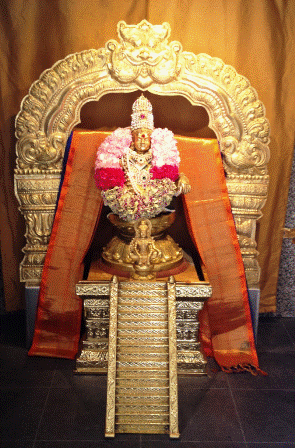
Sloka (Prayer)
Bhootha natha Sadaananda Sarva Bhootha daya Para/ Raksha Raksha Maha Bhaago Sastre thubhyam Namo Namaha//
Meaning
The protector of all created beings Ever blissful and merciful to all protect me, Sastha ,prostrations unto Thee Oh Great warrior !!! The Sanskrit term Arya-thatha means master of all senses, and word Ayyappa is the colloquial version of Arya-thatha. Sastha or Dharma – sastha means one who knows of all Dharma and Sastras. Popularly known as Hari-Hara-Sutha (Son of Hari — Lord Vishnu and Hara – Lord Shiva). Ayyappa is a unique symbol for God – the Brahman. In the Puranas, Lord Vishnu’s beautiful enchanting form of Mohini and Lord Shiva’s power of energy is well illustrated. Sri. Hanuman is considered as born out of Lord Shiva’s potency. In the same way, Ayyappa is regarded, as the Divine child of Lord Vishnu and Lord Shiva. The purpose of this Avatar is to remove ignorance (destruction of Mahishi-the buffalo headed demoness), spread of Vedic knowledge and protection of sincere devotees. Sabari, the tribal woman in the epic Ramayanam is said to have obtained Moksha after receiving the Jnana (knowledge) from Ayyappa and hence the famous temple in the state of Kerala where Lord Ayyappa is installed. It became known as the Sabari -mala Ayyappa temple. The pooja rituals at this temple follow both Vaishnava and Shaiva rites. The deity is always depicted in a characteristic Kirata-Brahmachari (hunting bachelor) posture with the right hand in the Jnana (Chin) Mudra. This posture symbolizes one’s yearning (hunting) for knowledge to remove ignorance. He demonstrates practicing moderation (Brahmachari), and dissemination of Knowledge (Jnana Mudra). A self realized person rides over all evil and animalistic tendencies and to show that Lord Ayyappa rides on a ferocious tiger! Another uniqueness of Ayyappa worship is that both the Lord and the devotees are addressed as “Ayyappa” strictly following the Vedic dictum ” TAT TVAM ASI ” – YOU ARE THAT (You are Divine). In many Ayyappa temples, the holy 18 steps are very sacred. Stepping on these 18 steps is considered very auspicious. The 18 steps symbolize the 5 senses, the 3 gunas, the 7 swaras, ignorance, knowledge, and the mind. Moreover, 18 is a al number in Hindu tradition – 18 chapters for Gita, 18 puranas, and so on.
-

Saraswathi

Sloka (Prayer)
Saraswathi namstubhyam Varade Kaama roopini/ Vidya-Aarambham karshyaami Sidhir Bhavathu me Sada//
Meaning
Prostrations unto you Oh! Saraswathi the splendid one Granter of boons And Desires Bestow your grace in my endeavor to seek Spiritual Knowledge. Knowledge personified (Vidya) as a feminine deity is Saraswathi. Sara means essence, Swa means self, so Saraswathi means the One who bestows the essence of one’s own self. The goddess is portrayed as sitting on a white lotus flower and wearing a white sari. She holds a sacred book in one hand, a lotus flower (or a Japa Maala) in the other, and she plays the Veena with the other two hands. The white lotus flower seat represents supreme realization of spiritual truth, while the lotus flower (or the Japa Maala) in the hand indicates to humanity the ultimate goal of spiritual realization. This goal can be achieved by two paths, the path of devotion (Bhakthi -shown by the Veena) or the path of knowledge (Jnana -shown by the book). The Vahana is the white swan, symbolizing the power to differentiate good from evil. Saraswathi is also meditated upon as the Veda-mata (mother of all knowledge) and Brahma-patni (Consort of Brahma). Brahma is the creating aspect of the Brahman and for creation, pure knowledge is essential and so naturally Brahma and Saraswathi go together. During the Navaratri celebrations, Goddess Durga is worshipped for the first 3 days to destroy all our negative tendencies, then Goddess Lakshmi for 3 days to cultivate all our inner qualities and during the next 3 days Saraswathi is worshipped to get pure knowledge. The tenth day is the day of victory (Vijaya -dasami) over all our evil and lower nature.
-

Muruga
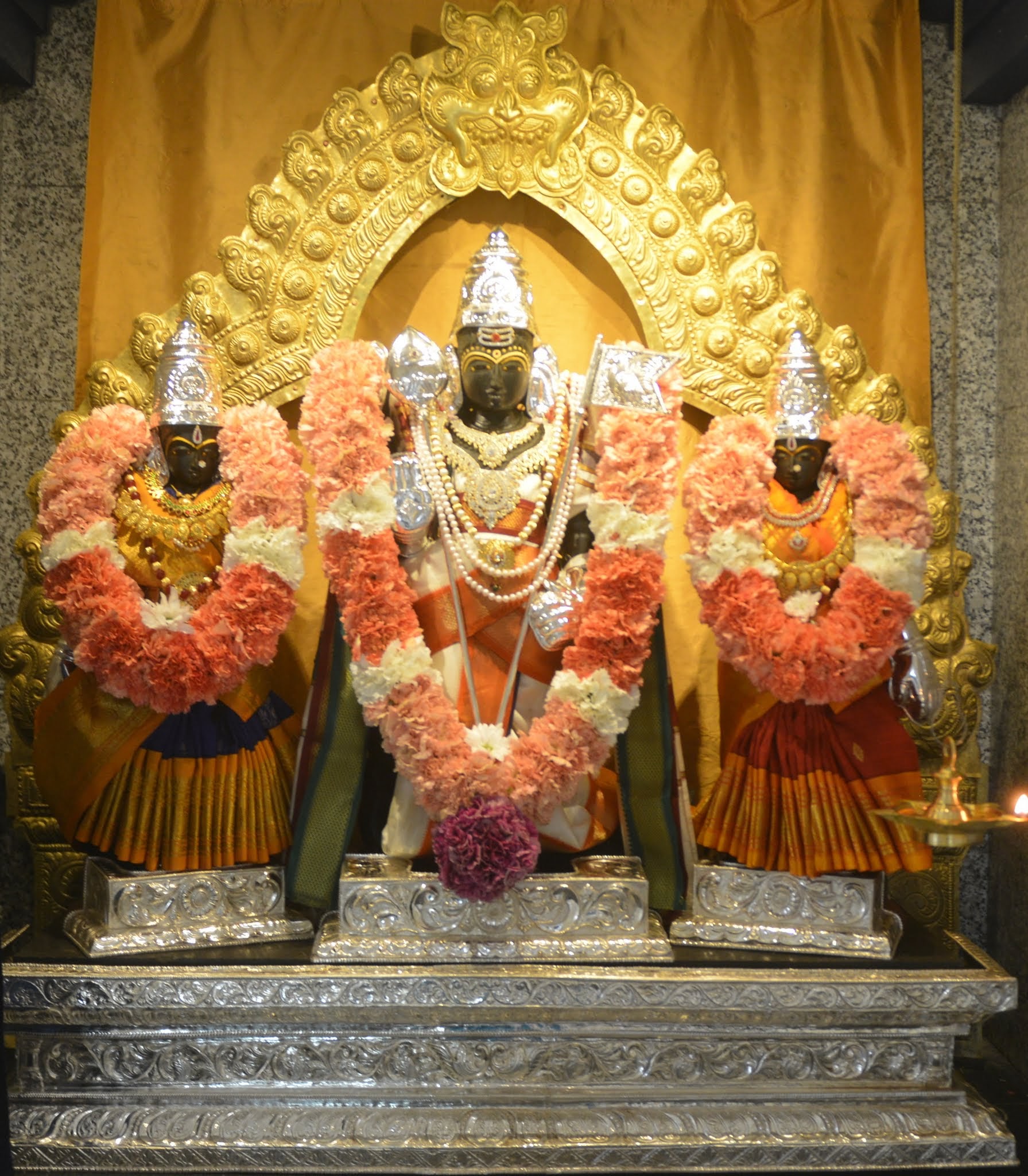
Sloka (Prayer)
Shada-ananam kum kuma raktha varnam Maha Mathim Divya mayoora Vahanam / Rudrsya Soonam Sura Saina Naatham Guham sadha aham saranam Prapadye //
Meaning
The six faced One, with the color of red vermillion, the one with al peacock as vehicle, son of Rudra Supremely intelligent Leader of the army of Devas Lord Guha! I take refuge all The time!! Lord Muruga is also addressed as Karthikeya, Subrahmanya, Skanda, Guha, and Shanmukha is a very popular murthi in Tamil Nadu and Sri Lanka. According to the Puranas (ancient Hindu stories), Subrahmanya is the second son of Shiva and Parvathi. He is the younger brother of Ganesha. Subrahmanya originated from the six sparks coming out of Lord Shiva’s third eye. The powerful sparks cooled and transformed into six children on a riverbank. They were reared by Karthika maidens (hence called Karthikeya). When mother Parvathi took in her hands the six babies at the same time, they all joined and became Shan-Mukha (the six faced One). Subrahmanya (Su = good, Brahman = God) means one who is conducive to spiritual growth, and thus represents the highest state of spiritual evolution. Known as Shan-Mukha (the six faced one), the six faces represent the 5 senses and the mind. The six attributes of the Godhead and also the six plexuses or chakras through which the Kundalini (coiled cosmic energy) is said to pass in yoga meditation. He is portrayed as Guha (Cave Dweller), which indicates that that God is in the depths of one’s body. The deity is depicted as sitting or standing. The luminous spear (the Vel) so characteristic of Muruga (Vel- Muruga), represents supreme knowledge (Sharp intellect). The two consorts of Karthikeya are Valli (literally vine clinging to the tree), and Devasena (the daughter of Indra). Along with Subrahmanya they are symbolic of Itccha-Shakthi, Jnana-Shakthi and Kriya-Shakthi principles (the power of will, Knowledge and Action). Subrahmanya is regarded as the commander in chief of the Devas. The Vahana is Mayooram, the blue peacock that clutches a small serpent. The serpent stands for ego, the peacock for vanity, and the blue color for infinity. Thus the message of the deity is very clear. For spiritual growth one should control ego, ride over vanity, destroying all uncontrolled desires (vasanas), and explore the infinite, with all the knowledge available and a sharp mind.
-

Lakshmi
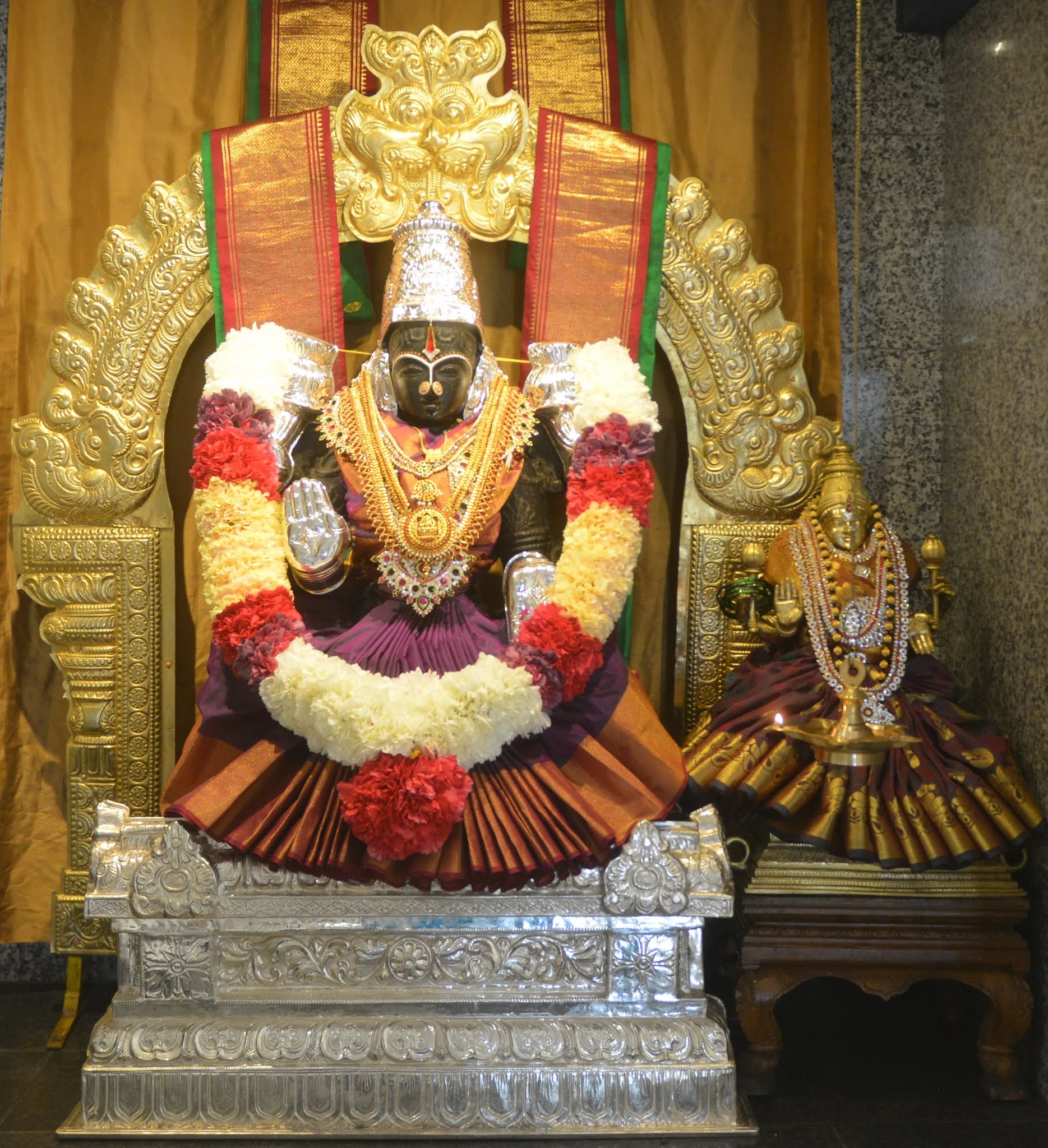
Sloka (Prayer)
Namasthesthu Maha maaye Sri peede Sura poojithe Sankha Chakra Gada Hasthe Maha-Lakshmi Namosthuthe
Meaning
Prostrations unto the Great Illusion sitting on the sri Peeda, carrying conch, Discus and Mace, adored by Devas Oh! Maha-Lakshmi Prostrations unto Thee Worshipped as the Goddess of wealth and described as Swarna Hasta (Gold giving hands), Sri Devi is generally invoked by lighting a lamp on Tuesdays and Fridays. In Vedanta, wealth really means moral and ethical values. The Devi is depicted as seated (Padmasana pose) on a lotus flower holding lotus flowers. The lotus flower represents ultimate spiritual realization. Preservation and protection of anything needs wealth and resources, and so Lakshmi Devi is always contemplated as residing at the feet or at the heart of Lord Vishnu (Narayana Paada Pankaja – Vishnu Vaksha Stitha) and worshipped as the Divine mother.
-

Andal
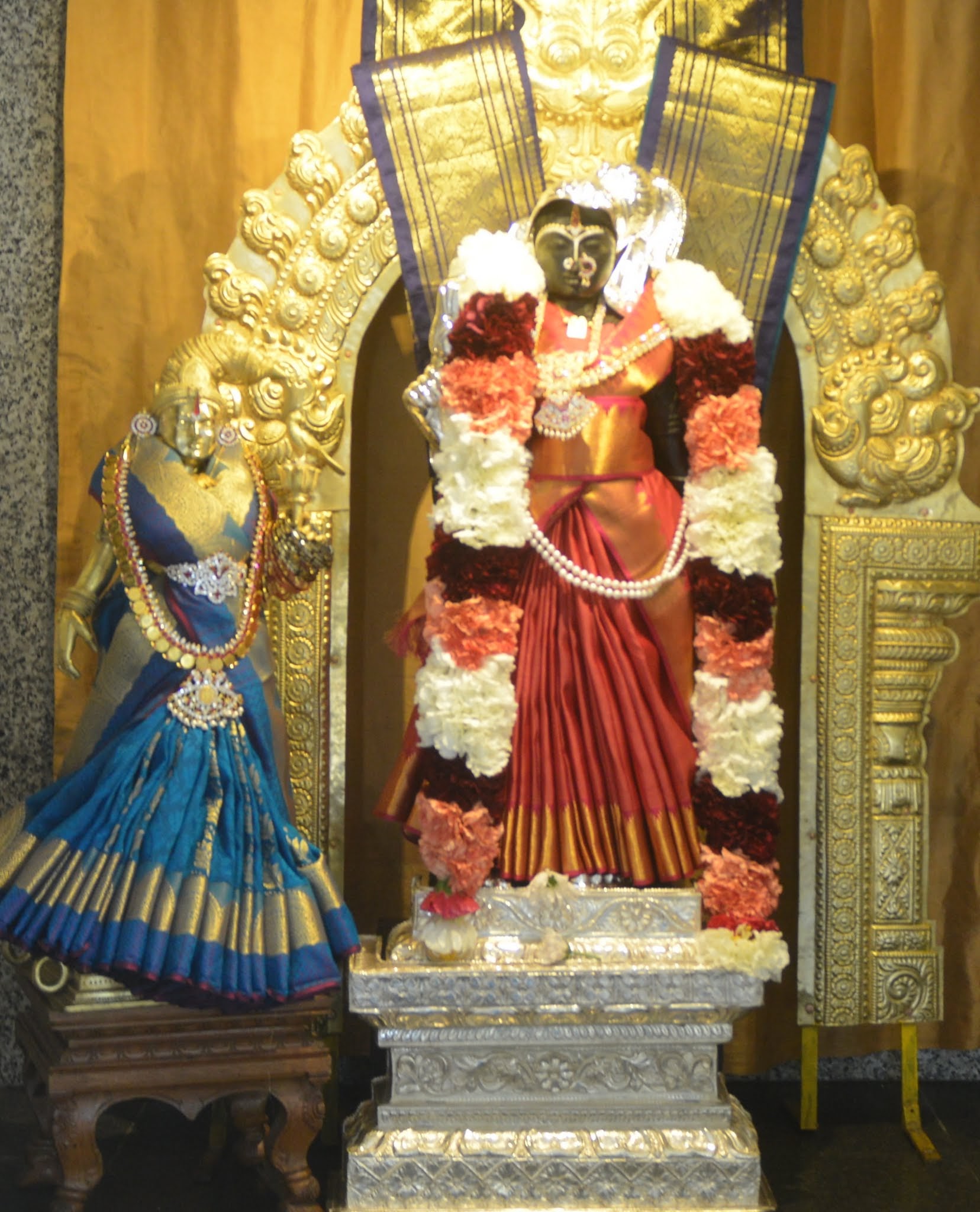
Sloka (Prayer)
Sri Vishnu chitha kula nandana kalpa valleem Sri Ranga raja Hari chandana yoga – drisyaam / Saakshaat kshamaam karunayaa Kamalaami Vaanyaam Godaam Ananya Saranam saranam Prapadye //
Meaning
I take refuge in Devi Andal, who always meditates on Sri.Vishnu , who got the vision of Sri Ranga Raja ( through yoga) who is the embodiment of compassion, Beauty and Patience !! Andal is one of the 12 great Alwars (pronounced Azh-wars). They are regarded as the utmost devotees of Lord Maha-Vishnu and believed to be divine incarnations of celestial beings appearing during the 7th through 9th centuries. The Tamil word Alwar literally means one who is immersed oneself (in devotion to Maha-Vishnu). They sang and wrote in ecstasy several devotional poems and hymns which are now referred to as the “Naalayira Divya Prabhandam ” (the 4000 divine Compositions). This also is sometimes called the Dravida -Veda. These saints toured several places, visited many temples and spread the path of Devotion and have profound legacy in our philosophy. The appearance of Andal is shrouded in mystery. A great saint and Alwar by the name Peria-Alwar found a baby girl (around 5 years old) amidst some Tulasi plants. This was near the temple of Vatapatrasayi Perumal (a Vishnu temple) at Sri Villiputhur in Virudhanagar district in Tamil Nadu, on Tuesday, the eighth day of the Tamil month Aadi , with the asterism Pooram, and thithi Sukla Paksha Panchami. The saint took her to his home, adopted her, and gave her the name “Kothai” (Godha). He instilled in her the devotion to the Lord as she grew up. He also used to make a garland to the deity at the temple everyday and offer to the Lord with great devotion. As Kothai grew up she became an ardent devotee of Narayana and insisted that she would marry none other than Sriman Narayanan. She also used to wear the garland prepared for the deity everyday by her father and admired herself in front of a mirror. Her father did not know this. One day, however, her father happened to see her wearing the garland and severely admonished her for doing such a sacrilegious act. That night he had a dream in which the Lord admonished him and insisted that from that day onwards, the Lord wanted only a garland that had been worn by Kothai previously! The Divine nature of Kothai was thus realized by all and she was respectfully addressed as ANDAL (the One who reigned). The love, trust and reverence of Andal to the Lord was complete and unconditional. From that day onwards, each day the deity was offered the Tulasi garland worn first by Andal. Together the father and daughter visited several holy places, especially Sri Rangam a great Vaishnava center. Legend is that Andal finally was granted her boon of being the bride of the Lord, in the Tamil month of Pankuni with the asterism Uttaram (Pankuni Uttaram ). Thiruppavai, a collection of 30 devotional hymns by Andal is extremely devotional and melodious. In these verses, Andal yearns for the eternal companionship and service to the Lord with unconditional surrender. Nachiar Thirumozhi is another set of 143 verses describing Andal’s restlessness and eagerness to be with the Lord. The Andal- Rangamannar (Lord Vishnu) temple at Sri Villiputhur attracts thousands of devotees every day. Even today the Deity of Maha- Vishnu is offered a garland that has been first offered to the deity of Andal. Sri Andal is always depicted with a unique hairstyle and garlands. Dressed as a bride, Andal carries a parrot on the left shoulder symbolizing wisdom, devotion and sweet music.
-

Shiva
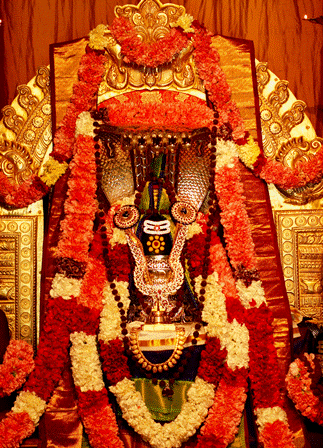
Sloka (Prayer)
Nama Shivaya Sa-Ambaya Sa-Ganaya Sa-Soonave / Sa-Gangaya Sa-Nandine Sa-Vrikshaya Namo Namha //
Meaning
Prostrations to Shiva who is always with Amba,Ganas, Ganga-maayi,Nandi and all created Beings. The famous Shiva shrine at Kancheepuram is known as Ekamabareswara (Ekam = one, ambara = celestial, Iswara= Lord) literally meaning the one Lord! Lord Shiva is portrayed in the “Linga ” form (Roopa). Shiva means auspicious, pure and stands for pure consciousness. Lingam means a symbol. The Super consciousness is portrayed in an ellipsoidal (elongated sphere) three-dimensional form. When an ellipsoid is cut along its axis we get an ellipse, the shape of the pathways of earth, and other celestial planets. When the ellipsoid is cut right angle to the axis we get a circle. The circle has no beginning and no end. It is all encompassing. Every point in the circle is as important as any other point. Thus a circle can represent supreme reality and infinity. Thus in the Shiva Lingam, God, or The Brahman is portrayed as having both a form (Saguna Brahman), and also with no form (Nirguna- Brahman). Since Purusha (Shiva) and Prakrithi (Shakthi) are inseparable, the Shiva Lingam is always mounted in yoni peedam (yoni = place of origin-creation ). Shiva is also called Ardha-Nareeswra thus; both Shiva and Shakthi are depicted. It may be mentioned that according to modern science each person have both male and female hormones and every man has “a little woman” in him and vice versa! Thus the concept of Shiva- Shakthi, Purusha-Prakrithi, Spirit-Matter, Lingam-Yoni as well as Ardha-Nareeswara helps us to understand and comprehend the “source of all!” At the Ekambareswara temple at Kancheepuram there are three unique items. The first, the Shiva Linga, is considered a “Prithvi” (earth) Lingam. There are five main Shiva temples representing the five Pancha- Bhoothas, which constitute the entire universe, thus pointing out the universality of Shiva. The second is a 3000 years old mango tree. Third is a huge Shiva Lingam, which contains 1000 small Lingams – a Sahasra Shiva Lingam. Lord Shiva is adored as the Abhisheka Priya – one who likes abhishekam– the ceremonial pouring of objects like milk, honey, and water with chanting of Veda mantras. By way of abhishekam a devotee can express the love and dedication to the Lord. The Sacred Bilva leaves are used for worship. The word Shiva when used as an adjective denotes good, peaceful and fruitful! The vahana of Shiva is the white bull – Nandi – a representation of pure Dharma. Dharma should be practiced with utmost determination (one should be Bull Headed as far the Dharma is concerned). The bull (Pasu – literally animal) also stands for Jiva, the individual soul and thus the Lord is called Pasu-Pathi.
-

Chandi
keshwara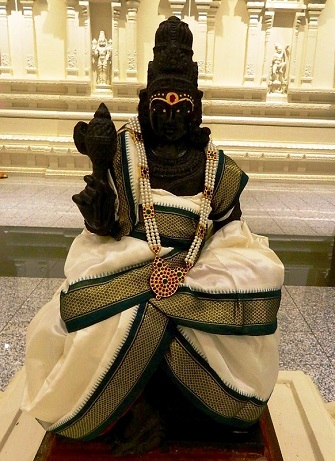
Chandikeshwara is a form of God which is often seen along with Lord Shiva, In fact, almost all the shrines of Lord Shiva has a portrait of Chandikeshwara. It is believed that no worship is complete without paying visit to him and hence devotees make it a point to visit him prior to visiting Lord Shiva.
-
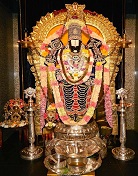
Venkateshwara
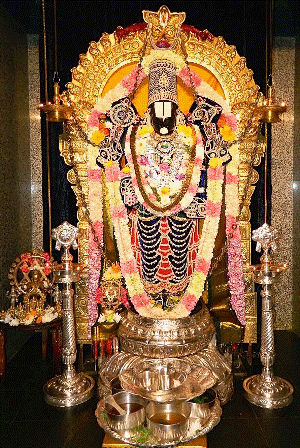
Sloka (Prayer)
Vinaa Venkatesham Nanaadho Nanatha Sadhaa Venkatesham smaraami smaraami/ Hare venkatesha Praseedha praseedha PriyamVenkatesha Prayaccha Prayaccha//
Meaning
There is no other Lord other than Venkatesha (for me) Venkatesha!! I always think and worship Thou (mentally) Oh! Venkatesha! Show mercy upon me, mercy upon me Oh! Vishnu! Grant me that is pleasing and good to me!! The word Maha-Vishnu literally means the Great Omnipresent. The Sanskrit word Vish means, “to pervade” and Vishnu means Supreme All -Pervading Reality (Viswa = Universe, Anu = atom, so universal Atom). Maha-Vishnu represents the power of protection and sustenance or preservation. Preservation or sustenance can be done with only wealth, and so Vishnu’s consort is Lakshmi Devi, the Goddess of wealth. Maha-Vishnu is also praised as Narayana- the glory of Nara (humans) because the Lord is the “Indweller” of all beings, and ” who frees living beings from all sins and leads them to eternity.” The most famous temple of Maha-Vishnu is the most popular temple in the world – the Sri.Venkateswara temple at Thirupathi, Andhra Pradesh. In temples, Maha-Vishnu is depicted in two ways. The first is as the yoga nidra posture (Ananta-Sayanam) lying on the serpent Ananta (or ego). The serpent is floating on the milky ocean (Pure mind) with hoods turned inwards (when thoughts are turned inwards, ego is controlled). Lakshmi Devi sitting at the feet of the lord (for a realized person all wealth, fame and prosperity serve at the feet). The second form is the Lord standing on a lotus flower (Supreme Truth), having a blue color (Infinity), yellow garments (Pitambaram – earthly attributes), a crown (Supreme Sovereignty over the entire universe). The four hands represent the anta-Karna (the inner equipment) namely the mind, the intellect, the ego, and the conditioned consciousness. The conch (Sankhu) on the upper left hand is symbolic of the whispering inner conscience, the destroyer of ignorance, and also the Nada-Brahman. The mace (gada) in the lower right hand represents the means of setting right all human wrong doings and failures. The discus (the Sudarsana Chakra) on the upper right hand symbolizes cycles of time (Kaala Chakra), preservation of order, moral values and proper functioning of the universe (Dharma-Chakra). The lotus flower with stem in the other hand denotes mother earth (as per Varaha Purana), as also the final goal of spiritual realization. The lord is also praised as carrying a sword (Nandaki) and a bow (Sarangi) for protection of the humans (See Vishnu Sahasranama – Vanamaali, Gadi, Saangi, Saghi, chakrai cha Nandaki, Sriman Narayano Vishnu Vasudevo abhi Rakshathu). The lord standing on a white lotus flower (Supreme truth) is often praised as Satya-Narayana! Vedic tradition dictates that all worship including pooja services and vrathas, regardless of any deity should be dedicated to Maha-Vishnu- (Yagnai yi Vishnu) and that is why at the temple whenever a pooja is over , the priest dedicates the pooja to Sriman Narayana (Kayeana vaacha—- Narayanayethi Samar prayaami). The lord’s vahana is the celestial bird Garuda indicative of omnipresence. Maha-Vishnu is adored as Alankara Priya and the murthy is always richly decorated, with garlands and flowers and the sacred Tulasi leaves.
-

Vishvak
sena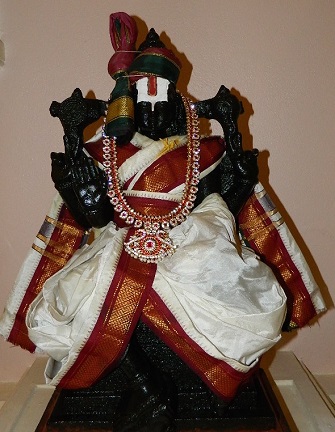
Vishvaksena or Vishwaksena, also known as Sena Mudaliar and Senadhipathi (all literally “army-chief”[1]), is the commander-in-chief of the army of the Hindu god Vishnu and the gate-keeper and “chamberlain” of Vishnu’s abode Vaikuntha.[2][3] Vishvaksena is worshipped before any ritual or function in some Vaishnava sects. He occupies an important place in Vaikhanasa and Sri Vaishnava temple traditions, where often temple festivals begin with his worship and procession.
-

Kamakshi
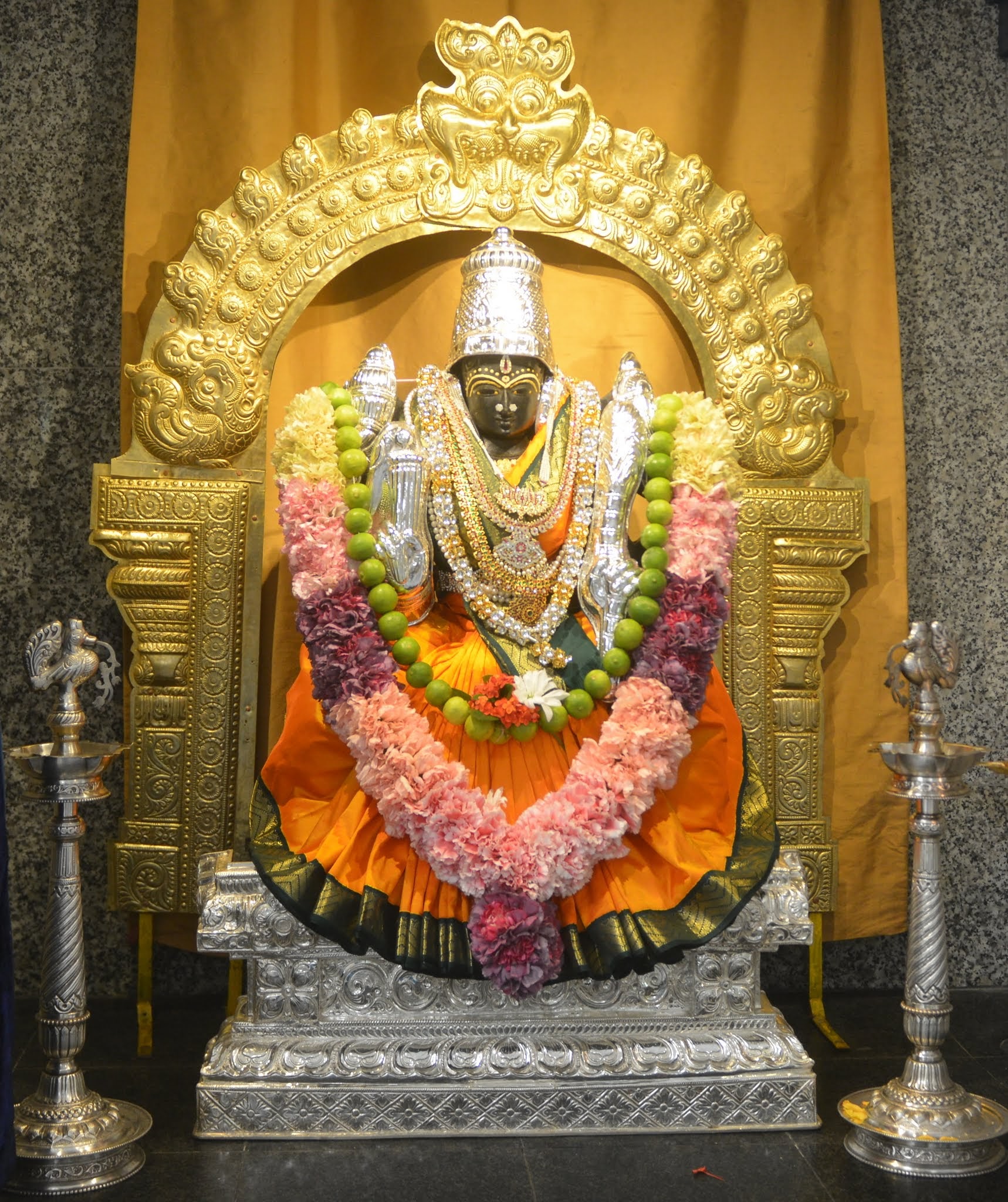
Sloka (Prayer)
Ekamranatha Dayi thaam Kamakshim Bhuvaneswarim Dhyayami Hrudaye Devim Vanchi Thartha Pradayinim//
Meaning
I meditate in my heart Kamakshi!, Beloved of Ekambaranatha, Goddess of the Universe and the bestower of desired objects Kama means desire and akshi means eyes – so literally Kamakshi means “the one whose mere glance full fills all our desires.” The name is used for the ancient deity of Shakthi (Devi), at the famous Kailasanatha temple in the holy city of Kancheepuram 50 miles west of Chennai in Tamil Nadu. Kanchi as the city is called is full of several Vaishnava and Siva temples. It is often called the “Dakshina Kasi” (The southern Benares). It was the capital of the ancient Pallva dynasty and at present, the famous “Kama Koti Peedam ” of Sankaracharya attracts several thousand devotees. Kamakshi or Shakthi represents cosmic energy in a dynamic form. The Devi is also addressed by other names like Durga, Parvathi, Ambika, Lalitha, Karthayini, and Meenakshi. In the ferocious ‘Kali’ form (time personified), Devi is portrayed with a drawn sword, destroying one’s selfishness, greed, jealousy, hatred, uncontrolled desires, and other evil tendencies. In the ‘Lalitha’ form the Devi is gentle and tender. The Lalitha Sahasranama praises the Devi in thousands of ways. Kamkshi is depicted in a sitting posture in Padmasana. The upper right hand carries a noose denoting worldly attachment, while the hook in the upper left hand emphasizes the importance (the sharpness) of righteousness. The sugar cane bow in the left lower hand represents the mature mind (Sweetness) and the sheath of arrows in the lower right hand symbolizes fine sense perception. Kamakshi reflects nature since the manifestation of the entire universe is ascribed to Shakthi (Devi). Worship of the Devi with KUM KUMAM and yellow lemon garland is very auspicious. The yellow color represents earth and offering red colored Kum Kumam is symbolic of surrendering our rajasic (worldly) tendencies.
-

Krishna
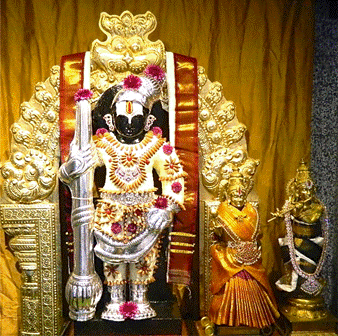
Sloka (Prayer)
Yatra Yogeswara: Krishna Yatra Partho MARGASHIRA dhara/ Tatra Sreer Vijayo Bhoothi: Dhruva Neethir mathir mama //
Meaning
Wherever Yogeswara Lord Krishna is Wherever the dynamic warrior Arjuna is There alone will prosperity ,victory and enduring welfare lingers !! The eighth Avatharam of Maha Vishnu, is often adored as the Poorna – Avatharam (Full Divine Incarnation). Every aspect of our Hindu life, history, and philosophy has been greatly influenced by Lord Sri Krishna. The lord is adored as a child (Bala- Krishna), as a cow herd (Gopala -Krishna), as the loving spouse (Radha – Krishna), as a super companion -(Gopi-Krishna), as a enchanting musician (Murali-Krishna), as a charioteer, and friend (Partha- Sarathi) and also as a Supreme Yoga teacher (Yogeswara)! Indeed the Lord takes several forms to lead us to realization. The very word Krishna means dark or black in Sanskrit. Since Atman is not known to many it is also described as dark or “Krishna.” Thus Krishna represents our own conscience, our inner Self, the Atman. The blue colored Krishna wearing yellow pitambara represents the infinite super consciousness in a finite human form. The hollow bamboo flute through which sweet music flows represents the sweet divine bliss flowing in a person who has become “hollow”, who has shed all desires and vasanas. The gopikas represent thoughts awakened by the Atman, dancing around the Atman since thoughts cannot go away from the Atman, just like Gopikas cannot leave Krishna alone! The Udipi Krishna in the famous temple at Udipi in Karnataka state is extremely beautiful and depicts Krishna as a small boy, with a churn-rod in one hand and a small rope in the other. The churn -rod represents the means of getting the essence (butter — the spiritual essence) and the rope represents tying away all our vasanas – the animal or the Pasu)! At Udipi one has to view this sacred deity believed to be installed by the great philosopher Madhawa-Acharya through spaces in a window, the famous kanaka-dasa window. Every episode in Sri Krishna’s life as described in the Bhagavatham whether as a child or grown-up is deeply immersed in ism and symbolism.
-

Uthsava
MurthisUthsavamurthis (Shiva and Parivara)
Uthsavamurthies are iconic representation of various deities of our temple. These are made of alloys of five metals (Panchalohas). These icons are mobile and are utilized for worship and procession (Uthsava) during various festivals. Traditionally the Shiva and parivar murthies are kept in a separate shrine from the moola Vigrahas. Vishnu & parivara murthies are kept in the same shrine with the moola vigrahas.
-

Rama

Sloka (Prayer)
Sri Ra- ma Ja- ya Ra- ma Ja- ya Ja- ya Ra- ma // Ramaaya Rama Bhadraaya Rama Chandraaya Vedase / Raghu naathaaya naathaaya Seethaaya Pathaye Namaha //
Meaning
Victory to thou Sri Rama ,Victory victory ! Prostrations unto Thou Oh! Rama, Rama Bhadra ,Rama Chandra The All-Knowledgeable, the supreme Leader of the Raghu Kula, Lord of Seetha Devi! Prostartions unto Thou!! Sri Rama is an Avatharam of Maha-Vishnu. An Avatharam (Divine Incarnation), attunes to the Brahman (Supreme Consciousness) at all times. In the puranas, Maha-Vishnu is said to have taken 24 Avatharams (Divine Incarnations), to protect and uphold Dharma. Of these ten Avatharams (Dasa-Avatharams) are considered very significant since many of them stand as allegorical representations of the stages of human development beginning with the Fish (Matsya), and attaining human perfection in the Rama Avatharam. The Rama Avatharam has been extolled in the immortal work of Sage Valmiki – the Ramayanam, and later by countless regional Ramayanams. Lord Rama is viewed as the ideal of perfection in all human endeavors, as a son, as a student, as a warrior, as a king, as a friend, as a husband, as a brother, as a noble enemy, as a magnanimous victor and so on. To illustrate this perfection and goodness Sri Rama is always portrayed, with Sita, Lakshman, and Hanuman – the famous Rama Parivaar. In the famous temple at Badrachalam in Andhra Pradesh, the Badrachala Rama is in a sitting (Padmasan) posture with Sita on the Lord’s left lap and Lakshmana standing near by. The togetherness of Sri Rama and Sita represents the Purusha-Prakrithi, or the matter – energy relationship, and the Paramatma – Jivatma principles. Besides Sita Devi also portrays the path of Devotion (Bhakthi ). Sri Rama and Lakshmana are always portrayed with carrying bow and arrows, majestically, symbolically stating the vigil, preparation and power to establish Dharma (Peace, justice and moral values). Sri Rama is the embodiment of Righteousness (Ramo Vigrava-van Dharma) and the lord can be worshipped at any occasion whether it may be birth, death, dawn or dusk! The word Ra-Ma is taken from the Siva Panchakshara Mantra ( Na Ma Si Va Ya ) and Narayana Ashtakshara mantra (Ohm Na Mo Na Ra Ya Na Ya ) and hence believed to be extremely powerful. Besides a prayer to Sri Rama, it is a prayer to Sri Hanuman. Likewise, a prayer to Sri Hanuman is a prayer to Sri Rama.
-

Ganapathi
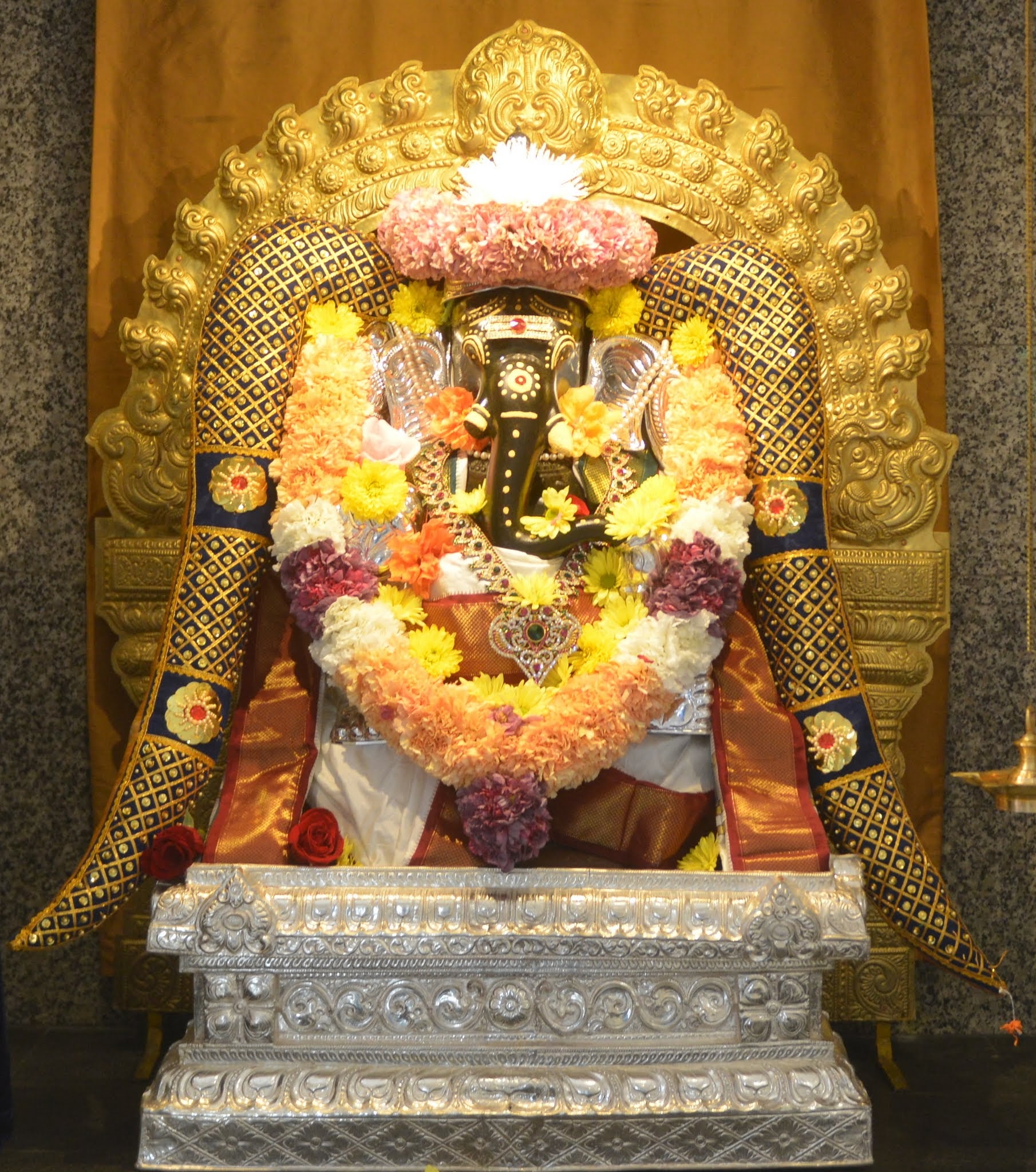
Sloka (Prayer)
Vakra Tunda Mahakaya Kotti Surya sama Prabha/ Avignam kuru me Deva Sarva kaaryeshu sarvada/
Meaning
The big one with curved trunk with immense brightness Lord! put no obstacles for in all endeavors always !! Literally meaning “the Lord of all Beings” the deity is also addressed as Vinayaka (the supreme leader) and Gajanana (the one with elephant face). The elephant head with large ears, symbolizes -listening to the eternal Vedic truths (Margashir of Sruthi), and also independent reflection upon these Vedic principles (Manana). The curved trunk indicative of the pranava (AUM) represents supreme intellect, which easily can judge what is good, bad, gross and subtle, just like a trunk of an elephant, which can pick up a huge log of wood or a tiny pin. The one broken tusk and the other whole tusk indicate that Divinity is above likes (Raga), and dislikes (Dwesha). A realized person should give one pointed attention to spiritual progress transcending the hurdles of opposites (likes and dislikes) of the material world. The large stomach is symbolic of the capacity “to stomach” and digest countless sorrows, and obstructions of the world of attachments. The snake that is tied to the body (either as yajnopaveetham or as a belt) represents energy in varied and whole form. The deity has four hands, indicative of the four anta-Karnas (Inner equipment), and four different things are held in each hand. 1. Pasam (noose) – to lead humans along the right path (Dharma) or a Rosary – to indicate continuous spiritual endeavors. 2. Ankusam (hook) or an axe – to goad the reluctant (hook), or cut across obstacles like uncontrolled desire, attachments, grief, disappointments (axe). 3. Modaka (sweet food)- indicating supreme joy of spiritual realization. 4. Padmam (Lotus flower) indicating ultimate spiritual bliss (or a broken tusk to show that nothing should be in our way to block spiritual endeavors. The vahana (Vehicle) of Ganapathi is the tiny Mouse (Mooshika) symbolic of our uncontrolled desires, which should be kept absolutely controlled, to attain spiritual excellence. If not just like a tiny mouse can eat away a huge granary, the uncontrolled desire can eat away, a person’s material as well as spiritual treasure in no time. One of the auspicious and popular offering for Ganesha in the pooja is puffed or flattened rice which can not further germinate to show us that one should completely annihilate all our uncontrolled desires to attain spiritual happiness. The offering of Durva grass a plant least coveted by humanity points out that God looks at all things equally. What you offer does not matter. How you offer is utmost important. The mouse also represents time and God-The Brahman is “above” time and not bound by time.
-

Anjaneya
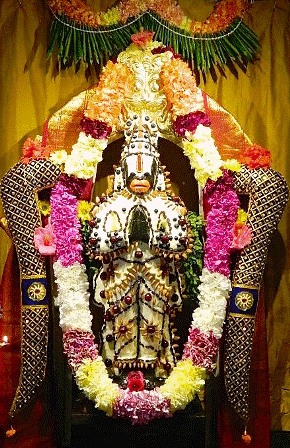
Sloka (Prayer)
Yatra Yatra Raghunatha kirthanam Tatra tatra krithamasthakanjalim Bhaspavaari paripoorna lochanam Maruthim namatha rakshsaanthakam
Meaning
Wherever Rama Nama is uttered there folding the hands in prayers with tearful eyes of devotion & joy stands Bhaktha Hanuman, remover Of demons and ignorance – whom I Prostrate again & again. It is a tradition among Hindus to conclude all worship services with a prayer to Sri Rama Bhaktha Hanuman. Hanuman is extolled for several acts of bravery and determination. The sage Valmikhi introduces Hanuman in the Ramayanam in a canto aptly called the “Canto Beautiful” (sundara Kandam). A monkey’s characteristic is to jump from branch to branch and so the fickle human mind is often compared to a monkey. Attainment of perfection is possible only, when the mind is totally controlled and kept focused on spiritual realization with Sheer determination and one- ness of purpose. Hence we have our Hanuman who rose to spiritual perfection, even though born in a monkey family, as son of Anjana. Thus he is also known as Anjaneya. Hanuman represents courage, determination, and selfless service born out of devotion, love, and knowledge of the Brahman. Hanuman is depicted as a huge figure carrying a mace (Gada), especially when crossing the ocean (Samudra Lankanam) and also bringing the Sanjeevani Mountain. The mace is symbolic of stern determination and oneness of purpose. In the war Anjaneya carries Dharma (Lord Rama) on his broad shoulders. Understandably, in front of mother Seetha, Anjaneya assumes a humble child like form. We can see that Hanuman -the chiranjeevi, portrays the eternal spiritual qualities of moral strength, humility, determination and selfless service. We read in the Ramayanam that Sri Rama bestowed “His Own Self ” unto Hanuman. In many temples Hanuman is installed as a member of Sri Rama Parivar. However in famous temples at Suchindram, Namakkal, and Bangalore, huge monolithic carving of Anjaneya- known as Veera _Anjaneya can be seen. This type of depiction, it is believed to have begun during the Vijayanagar period (14th Century), apparently to give hope and strength to the devotees, and also to ward off external threats from Muslim invaders. The strength and courage of Anjaneya is derived from two sources -Lord Rama (Sri Rama Dhootha dheeram) and Lord Shiva (Sri Rudra veerya samud bhavam). It may also be noted that in the Maha-Bharatha war, Anjaneya agreed to be present in the flag of victorious Arjuna. In our Shiva-Vishnu temple Hanuman is portrayed in a standing posture with hands folded in prayers (to Lord Rama), affectionately referred to as the Sri Rama Bhaktha Hanuman. It is a popular belief that a prayer offered to Anjaneya is tantamount to prayer offered to Lord Rama -nay to Para-Brahman itself.
-

Nandi
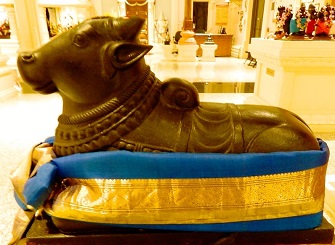
Nandi is the name for the bull which serves as the mount (Sanskrit: Vahana) of the god Shiva and as the gatekeeper of Shiva and Parvati. In Hindu Religion, he is the chief guru of eighteen masters (18 Siddhar ) including Patanjali and Thirumular.[1] Temples venerating Shiva display stone images of a seated Nandi, generally facing the main shrine. There are also a number of temples dedicated solely to Nandi.
-

Navagrahas
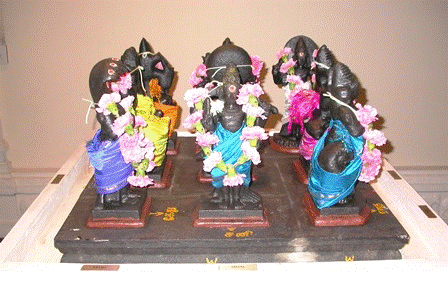
Sloka (Prayer)
Aadhithyaaya Cha Somaaya Mangalaaya Bhudhaaya Cha Guru Shukra Shanibhyascha Raahave Kethave Namaha The Hindus believe that the Nava Grahas or nine planets influence the life of the individual and the course of history. They are Ravi or Surya or Adithya (sun), Soma or Chandra (moon), Mangala, Kuja or Angaraka (Mars), Budha (Mercury), Brihaspati or Guru (Jupiter), Shukra (Venus), Shani (Saturn), Rahu and Ketu (ascending and descending nodes of the moon). In our temple Navagrahas represent the nine principal heavenly planets that influence man’s life. They are considered different aspect of Paramaathma. They confer different benefits like good health (Surya-Sun), Victory (Chandra-Moon), wisdom (Budha-Mercury), honor (Guru-Jupiter), vocal skills ( Sukra-Venous), joy & happiness (Sani-Saturn), strength (Rahu), personal opulence (Ketu), and family prosperity (Angaraka-Mars). The individual planets are given definite placement, within the nine fold group; as also definite orientations with reference to the cardinal directions. The image of Surya is at the center of the planets facing East with the other Grahas placed around him. They also have precise sculptural features and each have a vahana. The names of seven days of the week are derived from the first seven planets. Performing Navagraha Homam is very auspicious.
-

Garuda
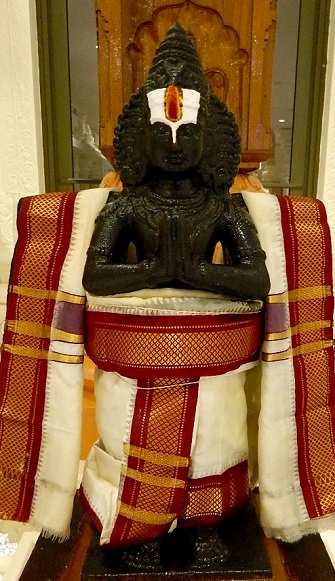
The Garuda is a large bird-like creature, or humanoid bird that appears in both Hinduism and Buddhism. Garuda is the mount (vahana) of the Lord Vishnu. Garuda is the Hindu name for the constellation Aquila. The brahminy kite and phoenix are considered to be the contemporary representations of garuda.[1] Indonesia adopts a more stylistic approach to the Garuda’s depiction as its national symbol, where it depicts a Javanese eagle (being much larger than a kite).
-

Shiva
Rajagopuram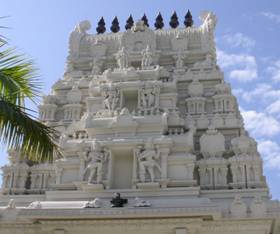
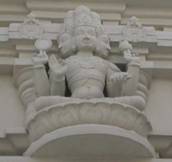
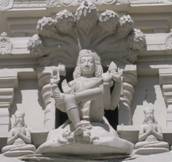 Shiva Rajagopuram is built according to the Chola period architecture (10th century). Each of the tiers has a pair of Dwara Palakas (entrance guards) at each level. The topmost tier has Nandi at each corner. Ganapathi and Subramanya icons are carved at the top level facing east. The southern face of the Rajagopuram has statues of Dakshinamoorthy at each level in various forms. The northern face has statues of Brahma at each level. Exclusive floral designs, Makaras and Nasikas are carved throughout all faces of the towers.
Shiva Rajagopuram is built according to the Chola period architecture (10th century). Each of the tiers has a pair of Dwara Palakas (entrance guards) at each level. The topmost tier has Nandi at each corner. Ganapathi and Subramanya icons are carved at the top level facing east. The southern face of the Rajagopuram has statues of Dakshinamoorthy at each level in various forms. The northern face has statues of Brahma at each level. Exclusive floral designs, Makaras and Nasikas are carved throughout all faces of the towers. -

Harihara

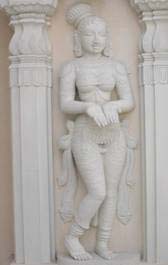
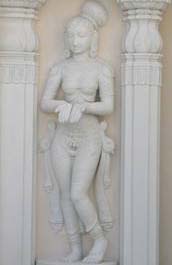 Our temple is a unique temple, where we have two Rajagopurams, representing separate entrance to Shiva and Vishnu shrines. There is hand full of temples with this feature in the whole world. Rajagopuram means kingly tower entrance. The peak of each Gopuram is decorated with seven copper kalashas with pointed ends reaching the heavens. The Gopurams are traditional structures designed according to Vaasthu Shaastras. Each tower has three tiers (levels) with rich ornaments and motifs. The Gopurams follow the same type of architectures noted in the shrines inside. The height of each tower is 38feet from the ground level. The entrance is decorated with beautifully carved teak doors with brass bells. The central entrance is decorated with shilabalakies on both sides and Harihara on the top. The central door is made of carved teak with brass bells.
Our temple is a unique temple, where we have two Rajagopurams, representing separate entrance to Shiva and Vishnu shrines. There is hand full of temples with this feature in the whole world. Rajagopuram means kingly tower entrance. The peak of each Gopuram is decorated with seven copper kalashas with pointed ends reaching the heavens. The Gopurams are traditional structures designed according to Vaasthu Shaastras. Each tower has three tiers (levels) with rich ornaments and motifs. The Gopurams follow the same type of architectures noted in the shrines inside. The height of each tower is 38feet from the ground level. The entrance is decorated with beautifully carved teak doors with brass bells. The central entrance is decorated with shilabalakies on both sides and Harihara on the top. The central door is made of carved teak with brass bells. -

Vishnu
Rajagopuram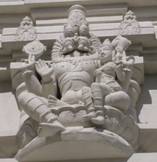
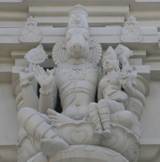
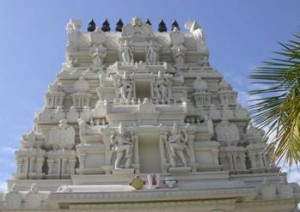 Vishnu Rajagopuram is built according to the Vijayanagara period architecture (12th century). Each of the tiers has a pair of Dwara Palakas (entrance guards) at each level. The topmost tier has Garuda at each corner. Standing Garuda and Hanuman icons are carved at the top level facing east. The southern face of the rajagopuram has statues of Narasimha Swamy at each level in various forms. The northern face has statues of Varaha Swamy at each level. Exclusive floral designs, Makaras and Nasikas are carved throughout all faces of the towers.
Vishnu Rajagopuram is built according to the Vijayanagara period architecture (12th century). Each of the tiers has a pair of Dwara Palakas (entrance guards) at each level. The topmost tier has Garuda at each corner. Standing Garuda and Hanuman icons are carved at the top level facing east. The southern face of the rajagopuram has statues of Narasimha Swamy at each level in various forms. The northern face has statues of Varaha Swamy at each level. Exclusive floral designs, Makaras and Nasikas are carved throughout all faces of the towers.

Write a comment:
You must be logged in to post a comment.